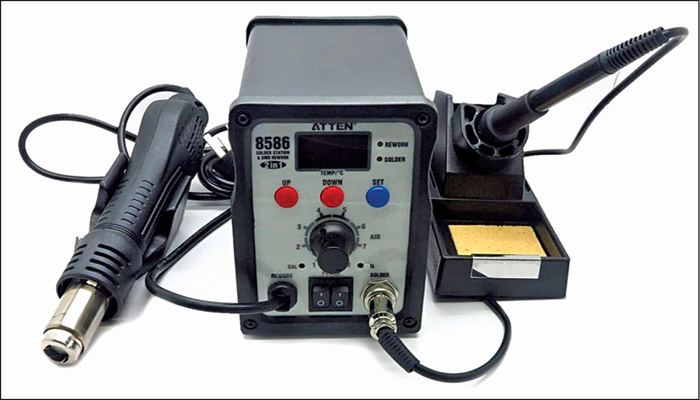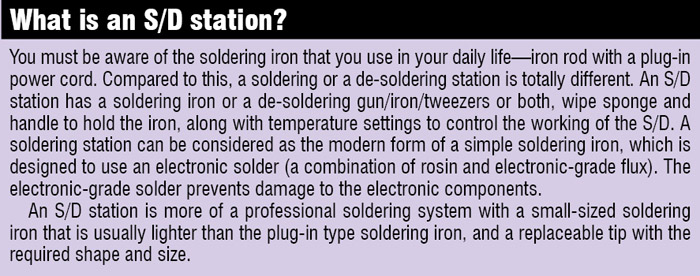Selecting the right soldering/de-soldering (S/D) station is very important for any project when it comes to printed circuit boards (PCBs) and semiconductors. Occasionally, we end up buying a cheap, unreliable S/D station that either causes damage to components or stops working after the first or second use. The hazards of selecting an incorrect S/D station were discussed in the buyers’ guide on rework stations published in January 2014 issue of Electronics For You.
It is advisable to know the required parameters before selecting an S/D station. But to know the parameters, it is essential that we know the basic requirement of the project in hand. From electrical to design parameters of the S/D, all should comply with the project to enable an efficient and safe working environment.

The next thing you should know is the new styles of S/D stations available. There could be S/D station styles with many old features incorporated along with the new ones. Information about the new styles of S/D will not only increase your options but also help you identify features you should look for.
Selection parameters
You must be aware of the common features that are considered as selection parameters for an S/D station, such as a replaceable iron tip, temperature control setting, pre-set temperature option, lightweight iron rod and output voltage of the iron. Apart from these, there are other important parameters that we generally miss out. These are electrostatic discharge (ESD)-safe design, thermal recovery, temperature accuracy and tip-to-ground ratings.
ESD-safe designs. All S/D stations work on electricity that gets converted into heat, creating an electric field around these. This may lead to electrostatic discharge at times, further creating device failures during S/D. The devices that we work on now-a-days are pretty compact and delicate to escape the damage caused. Thus, it is essential to look for an ESD-safe soldering station that prevents static from building up by grounding the iron.
Thermal recovery. The thermal recovery of an S/D is directly proportional to its power. An S/D station with low power will lose heat fast and will have a lower thermal recovery. Thus, an S/D station with low power will be slower to work with. Since thermal recovery of any S/D station is not usually mentioned on it, you should look for its power ratings. An S/D with a power rating of 50W to 80W is considered to be the best for fast operation, whereas an S/D station with power rating of 20W to 30W, or even lower, is unsuitable for most projects.
Temperature accuracy. It is natural to be curious about what this term is and why it is important. To clarify this term, let me take an example.

We set our S/D stations to a specific temperature for efficient work. However, do we ever bother to know if the tip of the iron has reached that temperature, or how close is it to the set temperature? The temperature accuracy gives us that idea. Ideally, the accuracy should be ±0.001°, which is impossible, but an S/D with ±5° of temperature accuracy is considered suitable.
An S/D station with adjustable irons and tips should have the accuracy calibration option to maintain the working efficiency of the S/D station.
Tip-to-ground ratings. This rating refers to two different parameters: potential and resistance. Tip-to-ground potential is the existing voltage between the tip of the S/D iron and the common ground of the station, and the tip-to-ground resistance is the resistance between the two.
The first is the leakage potential, which should not be more than 2mV, while the resistance should not be more than 5Ω. Otherwise, the overall current will leak out and the station will never provide the required efficiency at work.
New features to look for
You can never make the best choice if you do not have information on what is new in the market. Although you will find a few new styles of S/D stations with respect to their looks and design, the ones listed below are some of the new features.
Ultra-fast thermal recovery. You might have got a synopsis of thermal recovery in the previous few paragraphs, but ultra-fast thermal recovery is something even beyond that. Only a soldering station with high wattage like 120W or 150W can provide this type of recovery, allowing you to operate it at a very low temperature set point. This minimises your concern about the influence of heat on the components and the tip of the iron.






